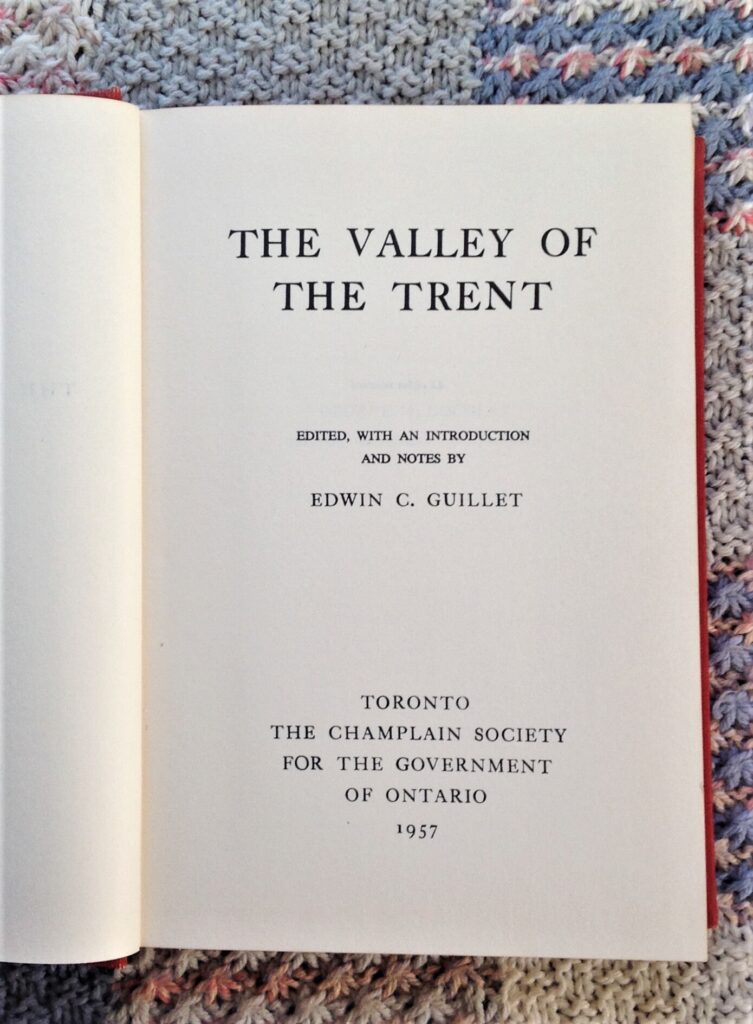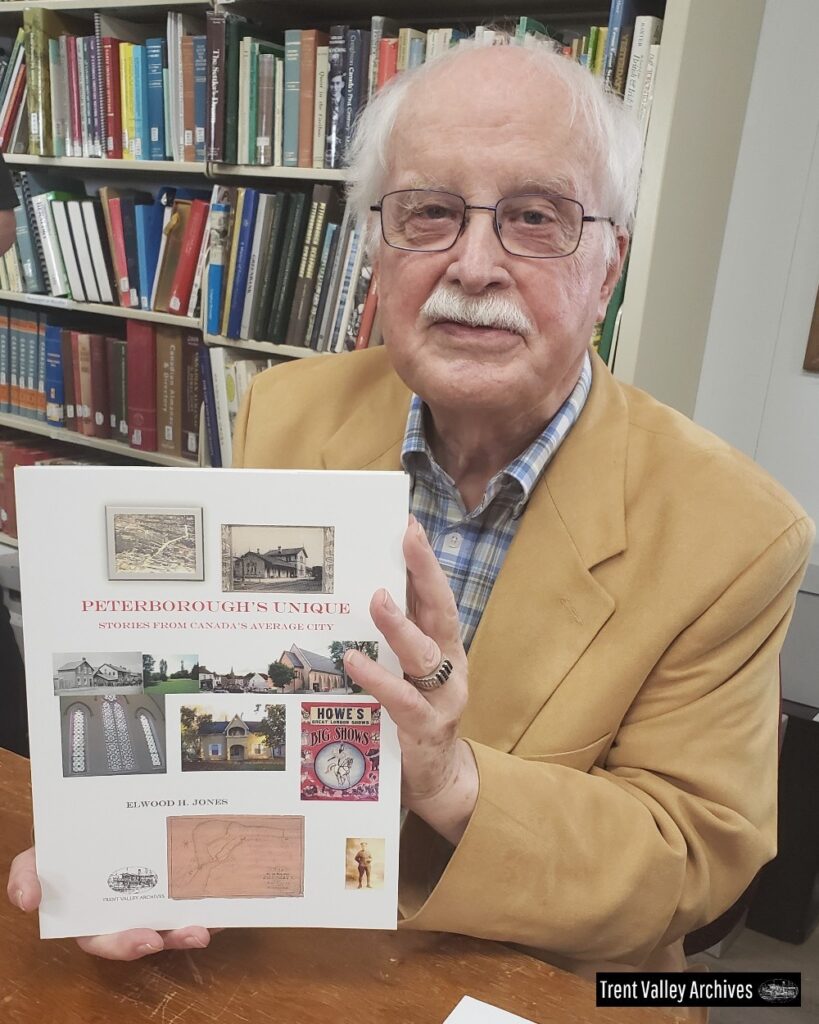
Edwin C. Guillet, ed., The Valley of the Trent, Ontario Champlain Series, Toronto, 1957, PP. lviii, 474, includes footnotes
Edwin Guillet’s volume on the Valley of the Trent remains one of my favourite books on local history. It has a fascinating introduction that shows real awareness of what historians were producing some 75 years ago and earlier. But it also includes a rich selection of archival documents that were otherwise inaccessible. It was the first volume in the new Champlain Series for Ontario sponsored by the Ontario government and remains an excellent guide to readers. I often recommend it to people who want a quick introduction to topics such as local indigenous history, pioneer transportation, the timber trade, mills, early education and literary pioneers in this part of Ontario.
It also has a generous selection of documents related to the Peter Robinson settlers. In his introduction he comments on “the Peter Robinson documents in the Peterborough Public Library form a group perhaps unparalleled in value outside the great archival Collections.” (p. lv; also p. 84) He adds “As the Peter Robinson documents have not previously been printed, it has been thought worth while to reproduce an adequate selection representative of the more characteristic items.” (p. lvi)
In the introduction to the selection of Peter Robinson documents Guillet says he reported on the value of these papers and the Archives of Ontario made photostatic copies. The Robinson papers were in the Peterborough Public Library but went to the Archives of Ontario until 1974 when Anne Heideman led an effort to repatriate them to Peterborough and they are now in the Peterborough Museum and Archives. There are several archival collections that include aspects of the Peter Robinson emigration, notably in the correspondence between the Governor General and the Colonia Office, in the emigration records in C.O. 384, and records in accounting and emigration offices. Descendants of the Peter Robinson emigration are blessed with the best and most complete documentation of any emigration.
Guillet’s selection of documents begins with the emigration placard published in Fermoy in 1825, “Emigration to Canada.” This poster attracted some 50,000 applications. Guillet comments that the historical value of Howard Pammett’s M.A. thesis for Queen’s which made extensive use of the Robinson papers “is lessened by an unnecessarily exaggerated bias against Robinson and the early aristocratic settlers in the region, but it contains a great deal of collateral material relative to conditions in Ireland and many other aspects of the Emigration.” (p 87) Trent Valley Archives between 1993 and 2023 made several efforts to publish the thesis but this ingrained bias made it impossible to edit.
Guillet then gives a sample of petitions and letters of support beginning with the documents related to the passengers on the Transport Resolution. He then looks at the emigrants on the Albion with the medical notes and comments of John Thompson, Surgeon R.N. Next he includes the notes of William Burnie, surgeon, on the Ship John Barry.
The next section contains ten letters sent to Peter Robinson about arrangements from Montreal up the St. Lawrence. There are comments on some emigrants.
His next documents come mainly from the Public Archives of Canada in Ottawa [now Library and Archives Canada], and many of these documents were microfilmed and some are available at archives such as the Trent Valley Archives. Peter Robinson described his arrival at the Depot [now Peterborough], written from Cobourg, 6 October 1825 to his brother, John. The deaths during the emigration were comparatively low. He suggested that the new place, “the prettiest place I ever saw,” should be called Wilmot Horton. He also commented on some unforeseen difficulties. [p. 109-110]
Next Guillet includes a letter from John Strachan to Wilmot Horton and one from Thomas A. Stewart to the Rev. James Crowly. Strachan notes that some of the emigrants not counted may have taken jobs working on the canals, and some may have rights as heirs to settle on land. Stewart refutes the false reports contained in the Colonial Advocate, published by William Lyon Mackenzie.
Next, there follows a letter from Sir Peregrine Maitland, the Lieutenant Governor of Upper Canada to Earl Bathurst at the Colonial Office, dated 31 March 1826, and includes comments on his recent visit to Peterborough. He notes that the emigrants had “good conduct” along the way and are now settled on their new lots. He says Robinson could explain “by what methods that good understanding, industry, and rapid advancement, so very conspicuous In both his settlements have been promoted, …” [p. 113]
Guillet then prints Peter Robinson’s detailed report, 4 May 1827, including his statistics to 24 November 1826, which is found in the Peter Robinson papers, as well as in the C.O. 42 papers (which are sometimes used by Guillet in PAC reports of the Q series.) [pages 115-125]
Guillet then prints the address from Patrick Barragan, requesting a clergyman and good school-masters. This letter is discussed in Rosemary McConkey, Green Routes (2023) and Guillet copied it from the appendix to the Select Committee of the British Parliament.., page 299]
Finally, Guillet chooses two documents commenting on the progress of the Robinson emigrants to 1847. First, Lord Grey to Earl Elgin, which Guillet copied from Papers relative to Emigration to Canada, pp 10-11. Grey observed that the total cost was L43,145, “no portion of which appears to have been repaid by the settlers.” In short, the Robinson experiment was entirely financed by the British government, something never again attempted. Second, Elgin’s response, gathered from public papers in London. He has a table summarizing cultivation on the lots, which were generally 100 acres. The surrounding areas were taken up by “voluntary settlement.”
Guillet’s generous selection of documents and his judicious observations should be welcome to all descendants of the Robinson emigration. He also draws attention to some other archival sources and reminds us that this emigration was exceptionally well-documented.
Book Information
Edwin C. Guillet (1898-1975) was educated at the University of Toronto (B.A. 1922) and at McMaster University (B.A. 1926; M.A. 1927). He joined the staff of Lindsay Collegiate in 1923 and the Central Technical School in Toronto in 1926, remaining until 1934. From 1958 to 1962 he served as research historian with the Ontario Department of Public Records and Archives. In 1963 he was appointed consultant on Canadiana to the Library of Trent University. He was the author of Early Life in Upper Canada and many other books, was noted especially for his works on social and local history.
Copyright Date: 1957
Published by: University of Toronto Press; Illustrated edition (Dec 15 1957)
Pages: 564
ISBN-10 : 1487599382
ISBN-13 : 978-1487599386
For purchase from Amazon (Canada):

| About the Blogger |
|---|
| Elwood Jones is a prominent Peterborough historian, esteemed member of Nine Ships 1825 Inc., Professor Emeritus of History at Trent University, and archivist at Trent Valley Archives. With a prolific career, Elwood has authored a dozen historical books, several pamphlets, and numerous articles, including over 300 columns for the Peterborough Examiner. He also serves as the editor of the Heritage Gazette of the Trent Valley and has been a long-time editor for the Peterborough Historical Society and the Canadian Church Historical Society. |
0 Comments